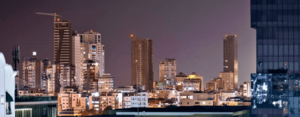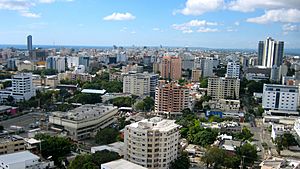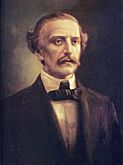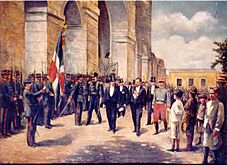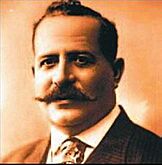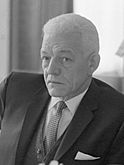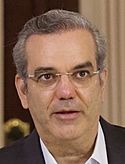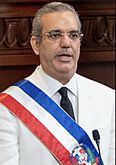Politics of the Dominican Republic facts for kids
The Dominican Republic is a country where people choose their leaders. It's called a representative democracy. The President of the Dominican Republic is like the main boss, leading both the government and the different political parties. The government handles the daily running of the country. Laws are made by the National Congress, which has two parts. The judges and courts, known as the Judiciary, work independently from the government and the lawmakers.
Contents
How the Government Works
The President and Executive Power
The President is in charge of running the country every day. They are the head of the country, the head of the government, and the leader of the Dominican Armed Forces.
The President chooses a team of helpers called the Dominican Cabinet. These ministers assist the President in governing the nation.
The President and Vice President are chosen together by a public vote. They serve for four years. They cannot be re-elected right away, but they can run for President again after at least one term has passed. Elections happen every four years.
The President has many important powers. They can choose most public officials and lead the military. They also handle relationships with other countries.
The Military
The Dominican Republic's military has about 45,000 active members. Their main job is to protect the country. They also help control illegal activities and people crossing borders without permission, especially from Haiti and towards the United States.
The Attorney General
The Attorney General is a top lawyer chosen by the President. To become Attorney General, a person must be a Dominican citizen, at least 35 years old, have a law degree, and have many years of experience as a lawyer or judge.
Making Laws: The National Congress
The power to make laws belongs to the National Congress. It has two parts:
- The Senate has 32 members. Each is elected for a four-year term.
- The Chamber of Deputies has 178 members. They are also elected for a four-year term. The number of deputies from each area depends on how many people live there.
The Senate has special jobs, like:
- Reviewing and approving new laws.
- Choosing members for important government boards.
- Approving the President's choices for diplomats.
- Deciding if public officials should be removed from their jobs for serious mistakes.
Senators and Deputies cannot hold other government jobs while serving in Congress.
The Judicial System
The Judicial Power makes sure that justice is served and that people's rights are protected by the Constitution and laws. The highest court is the Supreme Court of Justice. It has 16 judges. These judges are chosen by the National Council of the Magistracy. This group was created to make sure the courts stay independent.
The National Council of Magistracy includes:
- The President of the Republic.
- The President of the Senate and another Senator.
- The President of the Chamber of Deputies and another Deputy.
- The current President of the Supreme Court of Justice.
- Another judge from the Supreme Court.
The Supreme Court handles appeals from lower courts. It also chooses judges for those lower courts. It has the special job of hearing cases against the President, Cabinet members, and members of Congress. The Supreme Court also oversees all judges in the country.
Local Government and Areas
The Dominican Republic is divided into 31 provinces and one National District (Santo Domingo). Each province has a governor chosen by the President. Cities and towns have mayors and councils chosen by the people.
The provinces are: Azua, Baoruco, Barahona, Dajabón, Duarte, El Seibo, Elías Piña, Espaillat, Hato Mayor, Independencia, La Altagracia, La Romana, La Vega, María Trinidad Sánchez, Monseñor Nouel, Monte Cristi, Monte Plata, Pedernales, Peravia, Puerto Plata, Hermanas Mirabal, Samaná, Sánchez Ramírez, San Cristóbal, San José de Ocoa, San Juan, San Pedro de Macorís, Santiago, Santiago Rodríguez, Santo Domingo, Distrito Nacional, and Valverde.
Each province is divided into smaller areas called municipalities. These are further divided into municipal districts, rural areas, and villages.
Recent Political Changes
The Dominican Republic has many political parties, and national elections happen every four years. In the past, there were some concerns about how elections were run, but changes were made to make them more fair.
For example, in 1994, there were issues with voter lists. After this, political parties agreed to a "Pact for Democracy." This agreement shortened the President's term and led to a new election board. The 1996 election was seen as fair and transparent.
Since then, leaders like Leonel Fernández and Hipólito Mejía have been elected. They focused on improving the economy, education, and helping people in need. In 2012, Danilo Medina became President. The constitution was changed to allow him to run for a second term, which he won in 2016.
More recently, there was a discussion about allowing President Medina to run for a third term in 2020. However, he decided not to, saying it was time for "new blood" in leadership. The current President is Luis Abinader, who was elected in 2020.
Elections and Political Parties
Political Parties
Dominican Revolutionary Party (PRD)
The Dominican Revolutionary Party (PRD) was started in 1939. Its first elected president was Juan Bosch in 1963. The party has won the presidency four times. It is generally a center-leaning party. Its colors are light blue and white.
Dominican Liberation Party (PLD)
The Dominican Liberation Party (PLD) was founded in 1973 by former President Juan Bosch. They first won the presidency in 1996 with Leonel Fernandez. The PLD has won the presidency four times. It sees itself as a center-left party. Its colors are yellow and purple.
Modern Revolutionary Party (PRM)
The Modern Revolutionary Party (PRM) is another important political party. It used to be more left-leaning but has moved towards the center. Its main color is white. The PRM came to power in the 2020 Dominican Republic general election.
Elections
Presidential elections happen every four years on May 16. To win in the first round, a candidate needs more than 50% of the votes. If no one gets that many votes, the top two candidates have a second election 45 days later.
Political History
After many years of dictatorships or governments with problems, the Dominican Republic's government became more stable after the 1996 election. In this election, long-time leader Joaquín Balaguer lost power to Leonel Fernández.
The government is a representative democracy with a President who is the head of the country, the government, and the army. The President has a lot of power, including the ability to influence laws and declare emergencies.
The Dominican Republic has a close relationship with the US. Trade with the United States makes up a large part of the country's business. The country also has strong cultural ties with Puerto Rico.
Relations with neighboring Haiti can be difficult because many people move from Haiti to the Dominican Republic. Some people in the Dominican Republic blame this migration for social problems.
The Dominican Republic has trade agreements with several countries, including the United States and countries in Central America and the Caribbean.
See also
 In Spanish: Política de la República Dominicana para niños
In Spanish: Política de la República Dominicana para niños




